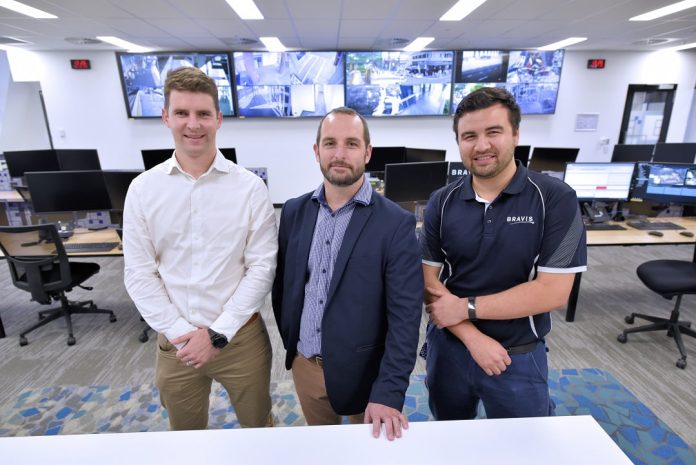Bravis Installs Integriti Milestone Axis – Brisbane City Police Station is the largest operational police station in Queensland and features a fully integrated access control and video surveillance solution. Integral to the solution is a state-of-the art control room allowing QPS officers to monitor their own site and gather situational awareness from thousands of cameras using remote video feeds via a dedicated and completely secure network with no connection to public internet.
The hardest thing to understand about the new Brisbane City Police Station is exactly where its electronic security solution ends. This is partly because the overarching management system is continuing to evolve, but the opacity of the solution’s sprawling hybrid topology and its growing role as redundancy for the State Police Operations Centre, feed into challenges of comprehension. On the ‘plane home to Sydney after my visit I keep casting around for the comfort of a defined border but there’s none to be found.
The local solution installed at Brisbane City Police Station is easier to conceive. QPS’ new building has video surveillance, access control, alarms, lifts and LPR access of vehicles as part of a suite integration, and these are managed in the site’s operations centre. Trouble is, as soon as you set foot inside that operations centre things get conceptually messy. That’s because the system’s operational capabilities extend much further than the cameras, doors and intrusion sensors downstairs on the street, bringing in multiple surveillance systems from across the city and across the state.
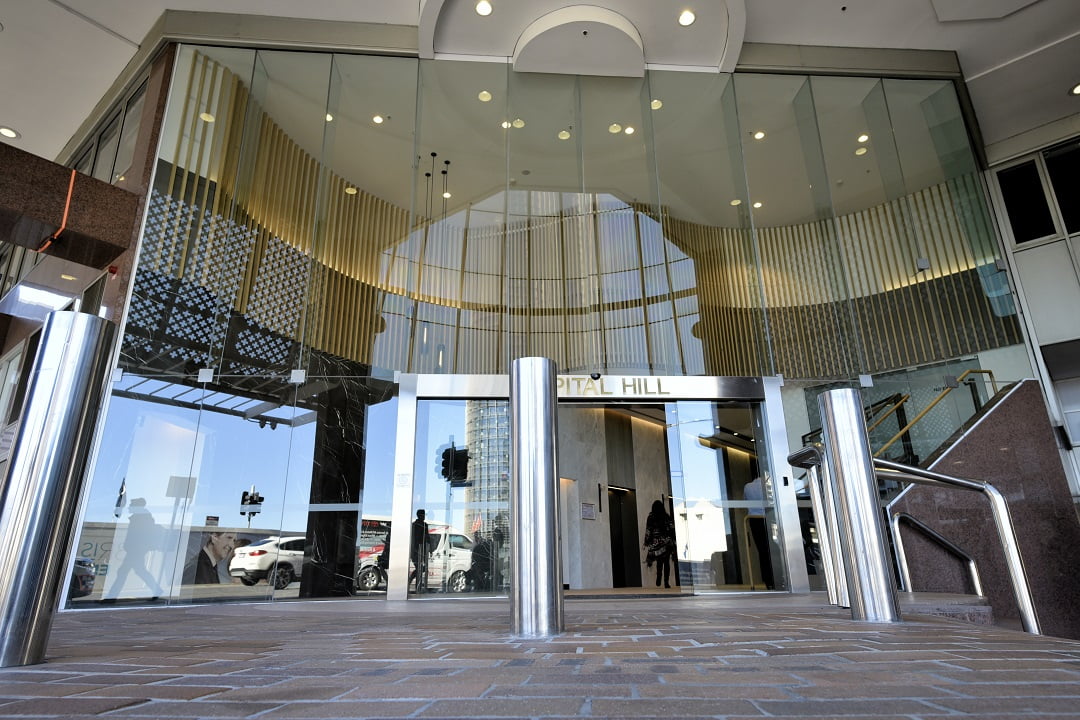
The site itself is flying under the radar – there’s a police station on level one with a glass front, but you would not know you were outside the largest police station in Brisbane. There are 48 cameras at the BCPS – external domes, internal domes and rugged Vivotek corner cameras in holding cells. Domes are located outside the building and on each level monitoring lobbies and other key locations. Coverage is by no means pervasive – the relatively shallow depths of field mean scenes can be managed with a wide-ish angle of view.
Brisbane City Police Station’s core CCTV system is built around Milestone XProtect VMS. Supporting Milestone XProtect is Dell computer hardware, which was selected thanks to a 3-year warranty with next day on-site service. There are more than 40 computing devices installed to support the system’s XProtect VMS, recordings, video walls and clients. Bravis has used Dell for years for its known quality and reliability, particularly in corrections environments. The video wall is made of up 20 LG commercial grade monitors and cameras are Axis vandal proof domes and the holding cells are equipped with Vivotek cameras which have anti-ligature points with an easy replacement lens cover and invisible IR.

External cameras integrated into the system are a combination of public safety and police systems, including Brisbane City Safe, QPS rapid deployment cameras, POLAIR for Gold Coast and Brisbane, a number of Queensland police stations, as well as Queensland Rail, Southbank Parklands and Roma St Parklands security and safety cameras. Importantly, this part of the system is about situational awareness in real time, 90 per cent of the time, so recording demands are slight.
On the access control side of the police station is Inner Range Integriti Version 18 supplied by CSD in Brisbane and this system comprises 56 Integriti hardware modules to handle access control, intrusion detection and duress). The system supports 79 doors, 5 lifts for 17 floors and the cardholder database of around 1200 is handled by a dedicated Dell server. Integriti Gatekeeper management software has a neat high-level integration with Milestone XProtect for LPR access control in the carpark. There are 9 Jacques audio and audio/visual intercom devices integrated with the Integriti system and these are supported by a dedicated server.
All this sounds straightforward enough until you start talking to Dan Cunningham from Bravis Security. At this point, his clever back-end configurations for Milestone and the epic nature of the overall solution become apparent. Feeding into the story is the fact the installation itself was impacted by local site complexity. This is a greenfield site inside a brownfield building and features multiple tenancies, one being very high security, the others arriving later. There are 3 parties involved in the local system – QPS, Department of Employment, Small Business and Training (DESBT) and building management – this means there are multiple instances of the management system but QPS has ultimate control.

“The building is a re-furb – this means everything is new, but the building is old, and this imposed limitations on space and infrastructure that had to be managed,” Cunningham explains. “We also had to decide how we were going to drive access control for the whole building, given there were multiple tenancies and the highest security requirements were those of QPS. Because of the evolving nature of the application, we built the system on the QPS back-end and then partitioned the later tenancies by adding additional Integriti panels.”
It’s at this point in the conversation that we arrive at the operations centre. Senior Sergeant Dan O’Connor QPS is responsible for security at Brisbane City Police Station – he’s also responsible for the day-to-day running of the operations room. O’Connor’s ready wit doesn’t disguise his intense operational focus and right from the start it’s obvious that, like Cunningham, he’s been plugged into this application from the beginning.
“We first approached Bravis to supply a solution for CCTV, building access control and intercoms at the planned Brisbane City Police Station,” Senior Sergeant O’Connor explains. “We chose Inner Range for the access control and Milestone for the VMS as they have a strong integration. But there was always a wider brief – we wanted the Milestone system to interface with multiple police and public safety CCTV solutions. The reason for this is that we wanted our operations room, which is used for QPS major events planning, to have the ability to deliver our team the best possible situational awareness in real time.”
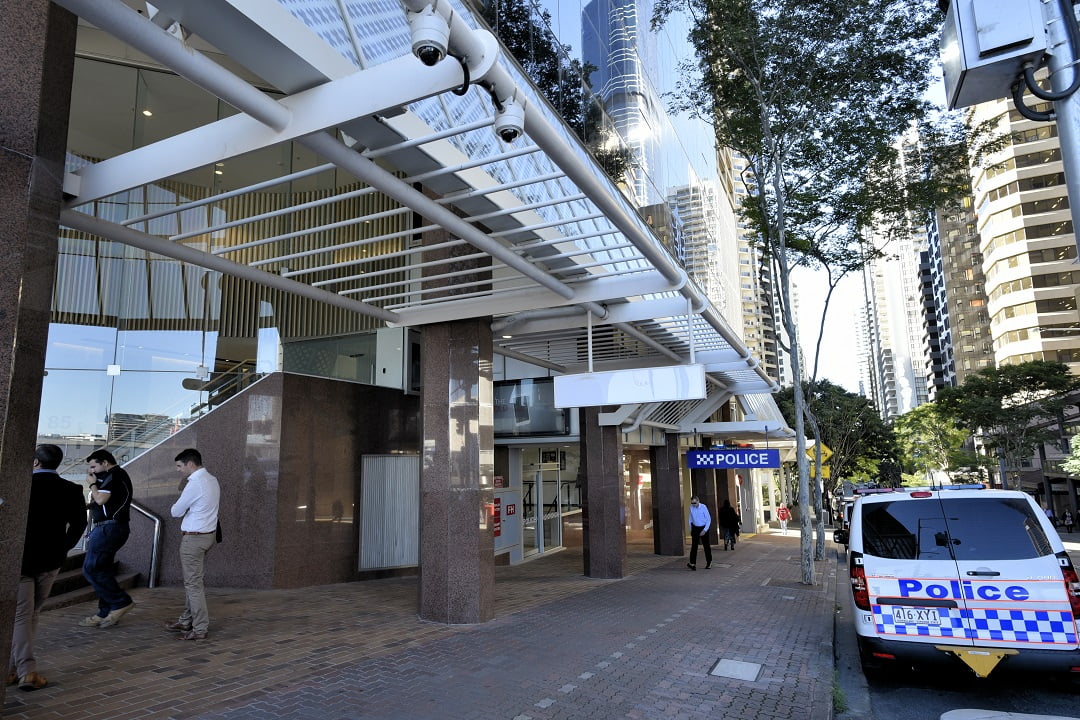
According to Senior Sergeant O’Connor, in the past, QPS went to Police Command Centre for intel from multiple CCTV systems but there were issues with this.
“State Police Operations Centre have different requirements to those of QPS – they are strategic and have a state-wide focus, while we deliver operational response for the Brisbane region,” he says. “Furthermore, their needs take precedence over ours. That means if something major happens in Queensland, we can’t depend on State Police Operations Centre to give us the video feeds we need here at Brisbane City Police Station. Also feeding into the decision was the fact all our assets are here – we do briefings downstairs – it makes sense for our operations centre to be where our team is and where we have line control. And there are redundancy benefits if the functionality of the SPOC is duplicated here and arrives here by completely different pathways.
“After consideration, we decided that in addition to getting situational awareness of the Brisbane CBD and to providing redundancy for the State Police Operations Centre, we would set up an operations room here with wider capabilities than were required for the secure management of this police station. We have a dedicated (completely secure with no connection to public internet) fibre from the State Police Operations Centre, so we can utilise selected feeds here in real time, meaning CCTV streams can be fed to us via Milestone Xprotect, if required.”
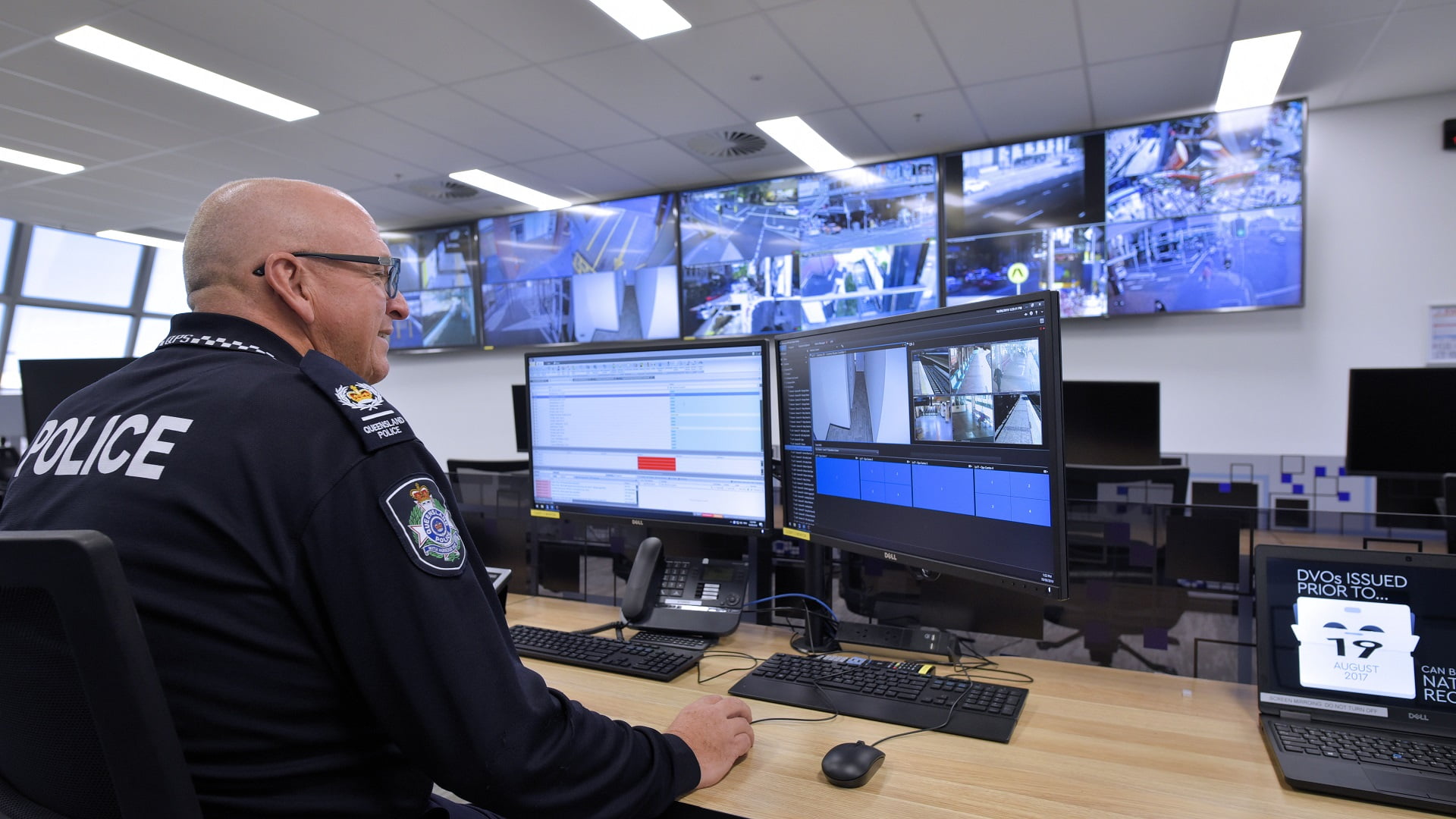
According to Senior Sergeant O’Connor, the operations centre is primarily concerned with events in Brisbane, so it’s local City Safe cameras that are most often viewed.
“Brisbane City Safe allows us to keep an eye on things going on around Brisbane, but we have wider capabilities if required,” he explains. “This system was incorporated into the upgrade of the building – not every police station has the capability or need to have an operations centre like this. Here in Brisbane we have many events we need to monitor – we have 600 protests a year – including one this morning where protesters blocked the road outside the GPO. The system gives us the ability to see the size of a protest, the nature of a protest, to see how traffic is effected and assess any other issues a protest might be throwing up.”
The operations centre has smaller spaces for conferencing during events and the CCTV system is configured to allow video streams to be moved around the room and around the building if required. According to Senior Sergeant O’Connor, the new facility would have been ideal to help QPS manage response to the 2011 floods. While the floods response team met regularly, it did not have the sort of situational awareness the new operations centre delivers.
“In the operations centre we can have Fire, QAS, SES and event team members which use our skillset for traffic mitigation – we would have 10-12 people here,” he explains. “Police are down the front where the radios are and we put external agencies over here and the commander (an inspector or superintendent depending on risk matrix of event), is at the command station at the rear of the room with overview. There would be a forward commander reporting to an inspector and senior sergeants or constables in charge of traffic, logistics, etc.”
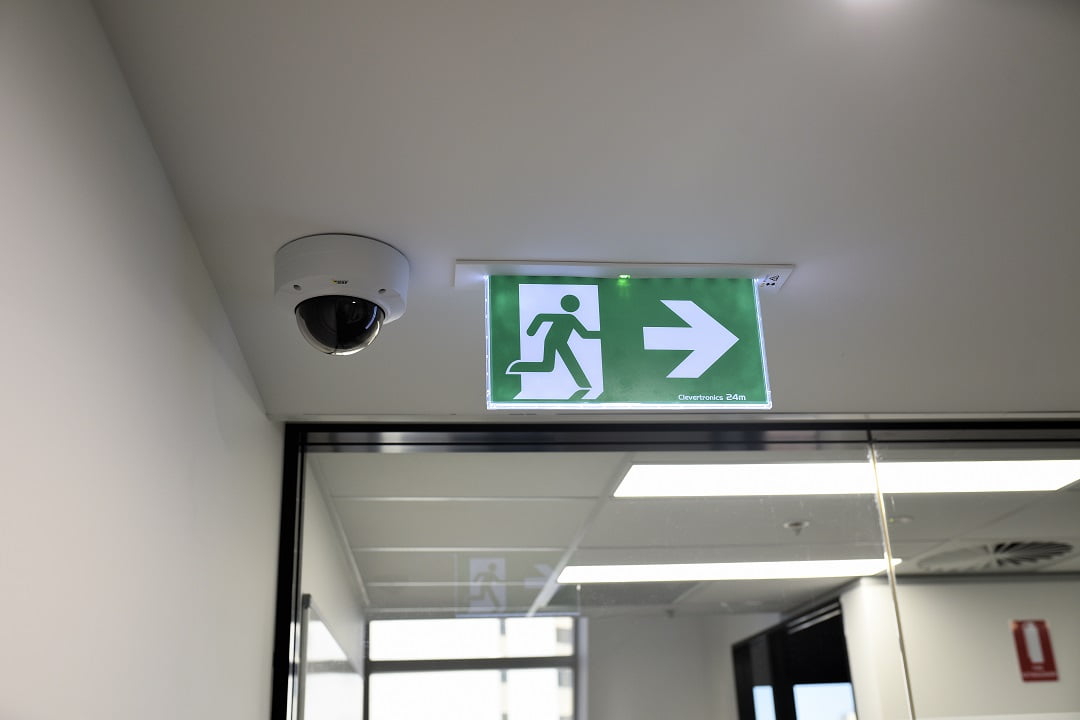
When an event is being planned do you decide which camera views you want brought into the operations centre? I ask.
“Yes, we currently go to SPOC to get the video feeds we need directed here, but we are looking at driving this independently,” Senior Sergeant O’Conner explains. “This is a process, because the organisations in question own and run their CCTV systems under MOU’s and the Privacy Act and we just get live feeds of camera views we need – things must be managed in the right way. This applies to Brisbane City Safe. If I wanted a street view, I’d ring up City Safe and request that say, camera 223 stay on its existing location and not be rotated because there’s is a public safety issue going on.
“City Safe is operational 24 x 7 so there’s someone available to adjust camera views and provide recordings to us on request. On Friday and Saturday nights there’s a police officer in the City Safe control room who will use the cameras for situational awareness and drive the cameras for us. Police and City Safe operators are in the same office, so the relationship is close. We also have an input into where new City Safe cameras are located, based on our knowledge of crime hotspots.”
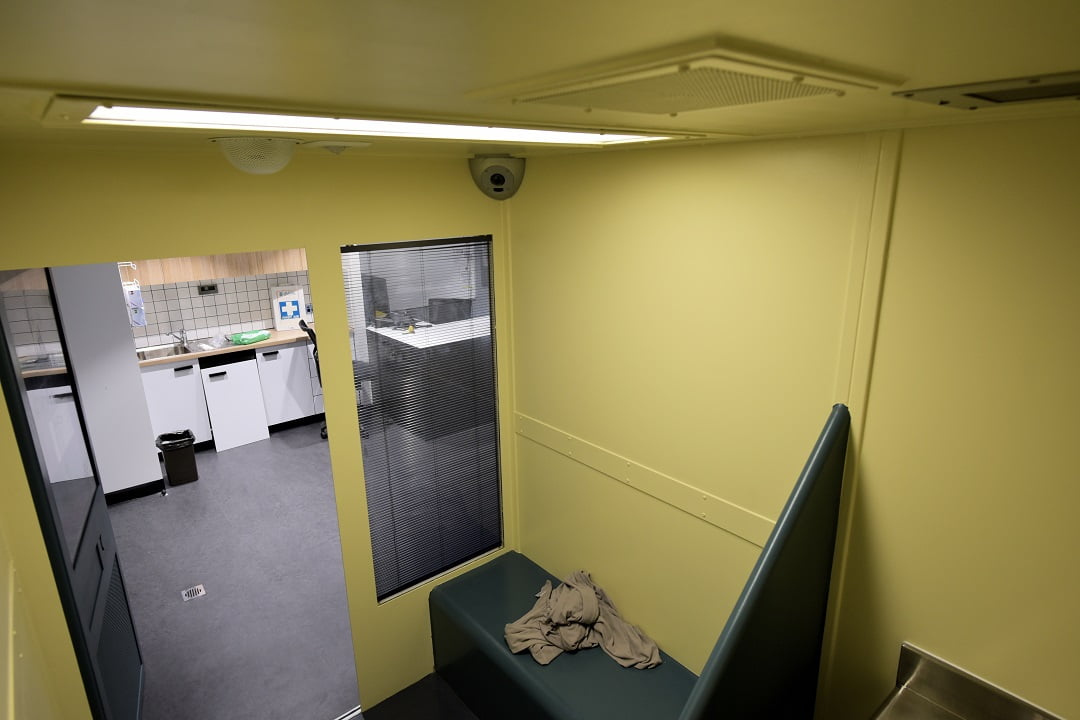
It’s clear that a central element of the application has been negotiating with relevant public safety system owners over an extended period – including before the refurbishment began. Bravis Security played a key role in this process but when talking to Dan Cunningham it’s impossible not to feel that the technical and human elements of the wider integration are melded together. Cunningham’s work in corrections as well as in major events over many years has given him an instinct for what’s required when creating such solutions and he has been able to communicate those concepts to multiple stakeholders.
“We’ve been working towards getting access to the different camera systems that QPS needs to see for a number of years,” Cunningham says. “There’s a lot to it – putting ideas together, working out the physical infrastructure necessary to deliver operational outcomes. For instance, how do we get completely secure, real time access to remote city safe camera systems. And getting engagement with the stakeholders is just the start. Then it’s about what hardware and software solutions they have, how they might integrate with our solution, what are we allowed to do with those video streams.
“We are lucky in that the State Police Operations Centre has gone through this process before, but we are still working, not just to create a funnel for situational awareness but to get access to the video feeds police need to pour into that funnel. Obviously, a key element of making such a solution function is secure networking that has no touch points to public internet. QR cameras come from SPOC directly, we have BCC going to another location and then coming into this building – we must find a secure path for each group of cameras. At the moment, most feeds are coming from SPOC via dedicated fibre, but we need to find redundant pathways so if HQ is compromised the overall functionality of these systems remains available.”
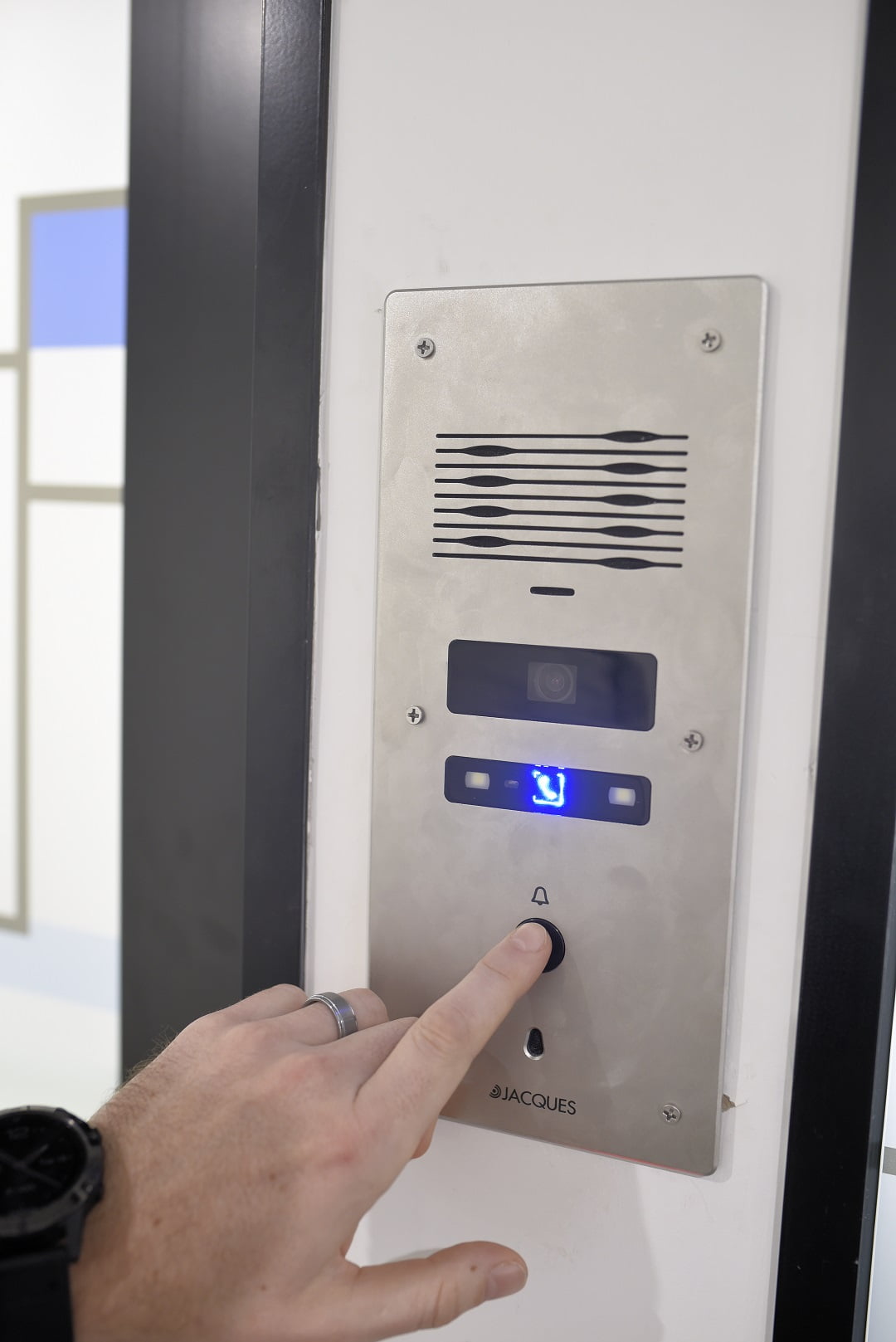
According to Cunningham, the QPS solution has been years in the making – not just materially but conceptually. And for Bravis and Cunningham it’s been the culmination of decades of experience. Cunningham’s work installing situational awareness solutions in prisons, as well as working with the State Police Operations Centre during G20, and with the Commonwealth Games, expresses itself fully in this application.
“The G20 in 2014 was the moment when funding and technology aligned to allow the delivery of a different sort of solution – a web application that allowed video streams to be viewed at multiple workstations, to be moved around a secure wide area network,” he explains. “Importantly for QPS, this is a native function of the Milestone XProtect system – it’s not an extra cost and allows additional features and functionality for QPS. That was a key aspect in this application.”
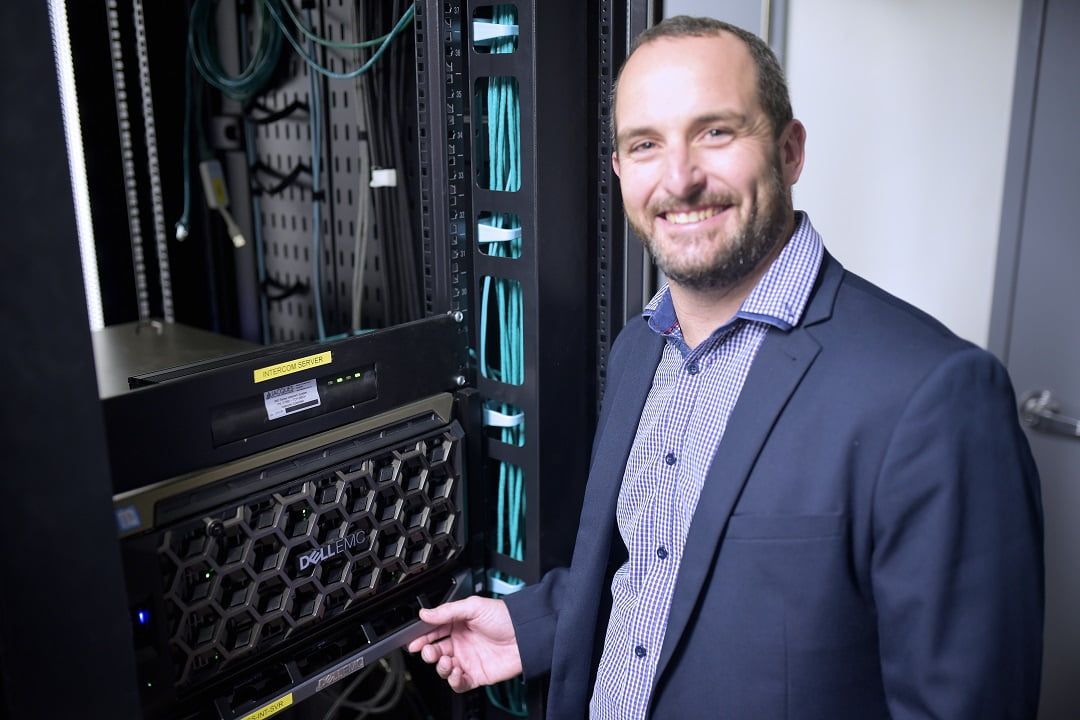
Dan Cunningham, Bravis Security.
According to Cunningham, the real key to the operational success of the system has been finding ways to bring multiple surveillance systems together from multiple locations.
“This is not easy from a technical perspective and there’s the human element to manage as well,” Cunningham explains. “It’s not just the external interest groups, there are 10 divisions within QPS that want system intel – we need to bring these systems together and then make video feeds available in a way that is simple to understand for operators yet completely secure.”
Bravis Installs Integriti Milestone Axis For QPS – Installation
Once planning was completed the installation at Brisbane City Police Station proceeded rapidly.
“The installation here took 5 months to completion,” Cunningham explains. “One of the tricky parts was the tenancy. QPS has 10 floors – some lower, some upper, and DESBT is in the middle with 9 floors. At the time the system was being planned and installed, QPS had no idea who was going to be on those middle floors but wanted fire-rated doors across the whole site. We had no idea who else would be here, either, so the application evolved to cover the entire building as we moved forward, with the QPS specification ultimately taking precedence.
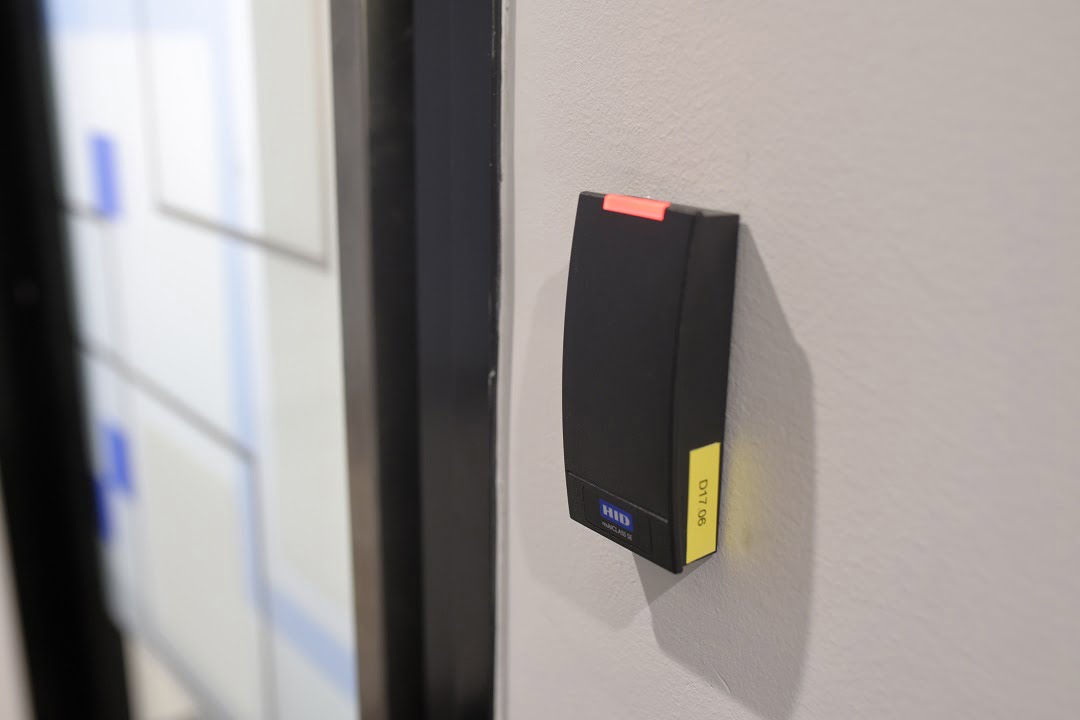
“An integration like this requires a lot of process control and the high-level management meetings that we had daily made everything work so that by the time we got to practical completion the system was fully functional and we brought the project in on time. That high-level meeting process was critical, given we were trying to make spaces work in ways for which they were not designed. The fact we worked with QPS right from the start was beneficial as the lines of communication were strong.”
The integration process included a lot of negotiating between QPS and builders and Bravis was in the middle of that.
“Because the project was so technically complex and challenging, we were constantly liaising with the builder and QPS and instructing both parties on how to deliver the project with minimal variations while delivering the desired outcome for QPS. There was loads of planning – paperwork – showing QPS what could be done and mapping out how it would be done – in real time in some cases. As this was going on and the installation was progressing, we had to approach different organisations to discuss integrating their cameras into the system, and to find appropriate external pathways.”
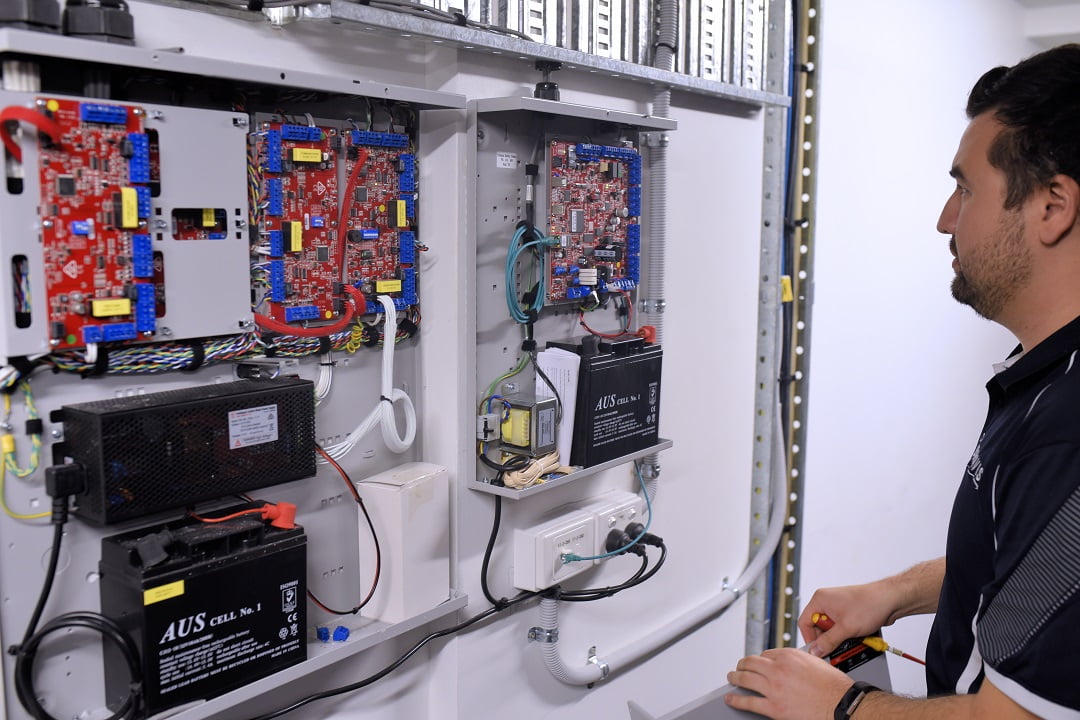
Daniel Maxwell examines the Integriti panels.
Another interesting aspect of this solution is storage – there’s storage of local cameras but not for cameras of other organisations.
“When it comes to storage of these camera views it’s tricky – because of legislation and MOU’s we don’t record video from external organisations – instead we display a live feed and if something is seen, then police approach those organisations and request recordings of camera views for times and dates in the usual way for police investigations,” Cunningham explains.
“And at the heart of the installation was use of completely secure networks – secure government networks, private fibre links, private wireless links – the system has no connections to public internet. The networking was challenging, and bandwidth is a struggle – we are always juggling bandwidth.”
According to Bravis Security’s senior security technician, Daniel Maxwell, the biggest local technical challenge was the carpark approach angle for the LPR.
“There are structures in the way demanding a wide swing from drivers and this meant ensuring consistent performance from the system was challenging,” he explains. “The LPR access control involves a clever high-level interface between Integriti and Milestone that interprets the plate data and the plate is registered as a credential under than user. The Milestone server does the recognition, informs Integriti and Gatekeeper drives the boom gate and registers the event and the credential holder. It’s a card but it’s a number plate. The HLI gives great flexibility between the 2 systems – it lets you pick and choose how you want to set up the system during integration.”
Bravis Installs Integriti Milestone Axis For QPS – Driving The QPS Control Room
While we’re in the operations centre, I can’t help sneaking a glance at the VMS interface and it looks surprisingly simple. When Cunningham takes the helm and starts driving, I understand why – it really is simple. There are obviously clever things going on in the background, but the VMS presents in a highly intuitive way, considering it has access to cameras across multiple sites.
Once I get closer to the screen, it’s possible to see why functionality seems so fundamental – there’s a tree for external systems that allows operators to select whichever site they want to view and populate their workstation with camera views, drop views onto the video wall, or push views to other parts of the building.
“With Milestone we created filters and one big site tree so operators can go to a remote site and drill down to live access camera views,” Cunningham explains. “We also needed to deliver camera views in a form that is easy to use, because different people are sitting in the room each day for different events. Part of our plan was working out how to build a system that’s intuitive to manage.”
To demonstrate how it works, Cunningham opens Queensland Rail in the site tree and QR stations come up. He selects a station and camera views appear – then he pulls a couple of camera views over and begins to populate the workstation screen. Something that’s especially neat is that the monitor can display cameras from multiple systems at a time – police might view 1 from Suncorp Stadium, 2 from QR and 2 from City Safe, simultaneously. It means police can decide what constitutes situational awareness from their point of view as an event unfolds.
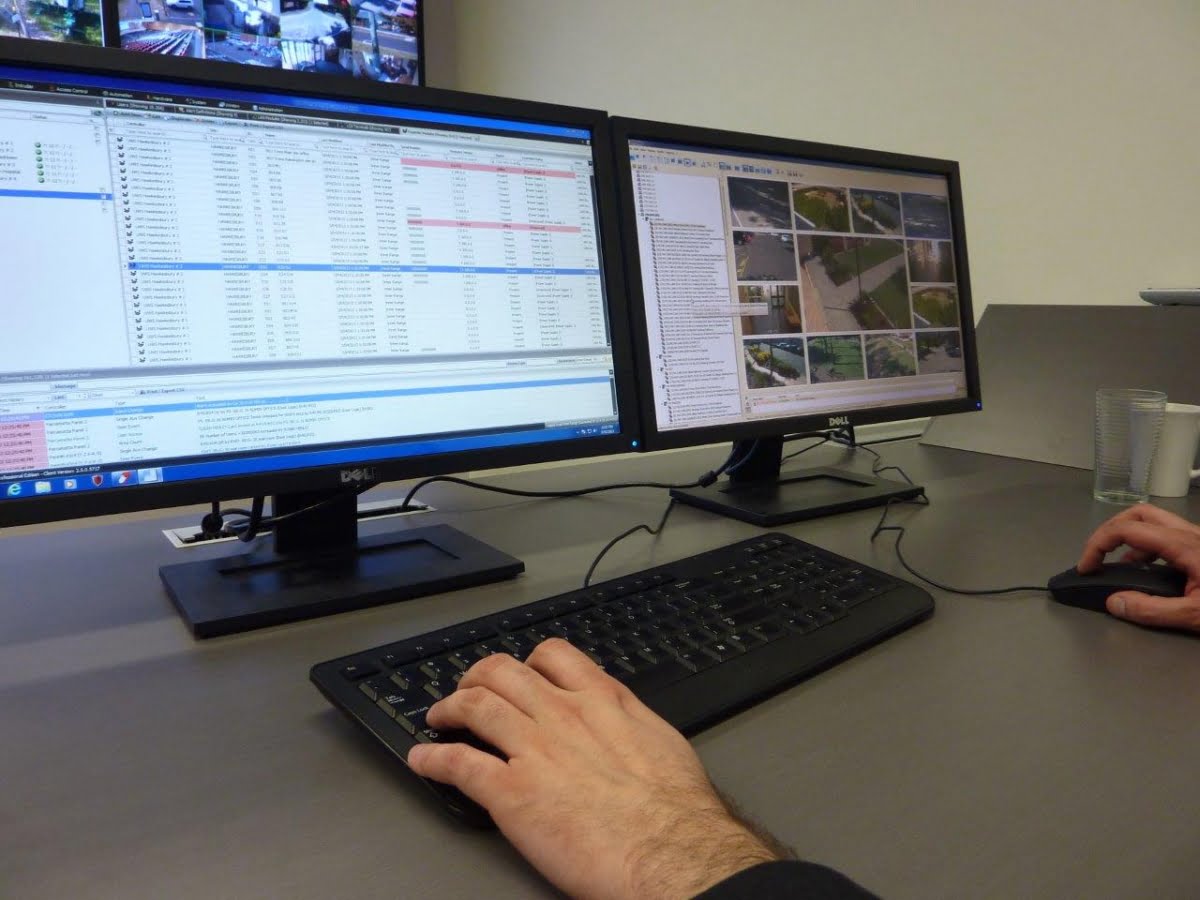
“The images on the workstation can also be thrown to the big video wall at the front of the room for general observation – it’s click and drag,” Cunningham explains. “The way it works is very simple – police are not here to play with the system but to gather operational intel in real time, so the interface needs to be easy to manage for any officer rostered into the ops centre.
“In the ops centre QPS has its own machines that officers view depending on the event. If it’s a traffic incident, operators are authorised to access traffic cameras, if it’s counter terrorism, then officers have a different group of cameras they can access. Each workstation becomes an officer’s own workstation when they log into it, so they can access all their usual things, as well as populate the screen with instant feeds for situational awareness of events.”
While we’re watching, footage from a police helicopter is added to the screen – you can see how beneficial it would be to the team in the operations centre to follow rapidly developing events in real time.
“This ability to pull together video streams from multiple systems is the heart of the QPS solution and it’s possible because there are so many different secure paths bringing the video feeds here,” Cunningham says. “You have to compare this with the way things were in the past when the police officer in the City Safe control room was the provider of verbal intel to QPS about real time events in the Brisbane CBD using a telephone.
“Now we can deliver cameras to the operations centre for incidents or for larger scale events. That was never an option before. And as the relationships are building between councils and police, the scope of the solution increases. A key thing in this process has been getting council and police talking – understanding that each has its own systems but when police identify there’s a problem, council will respond with eyes on the event and provision of camera feeds so police can decide how best to respond.”
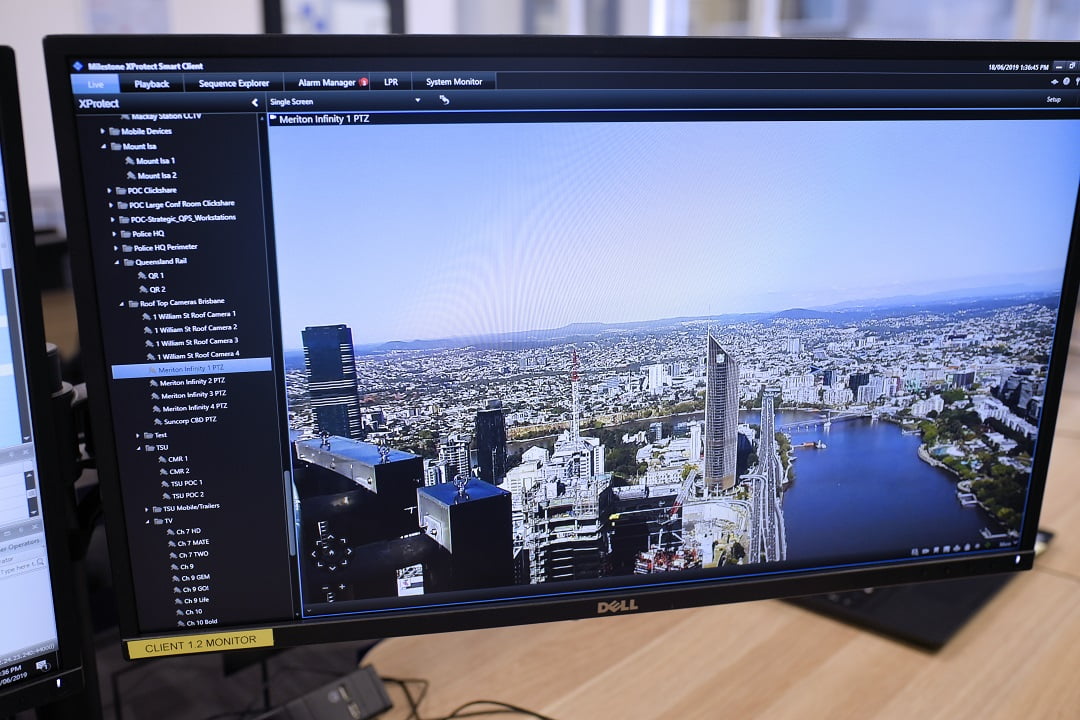
In some ways, the solution you’ve created is an intelligence funnel – you add any camera feeds that are needed to monitor a given event from any system to which you can connect – and that demands a relationship, not a one-off arrangement, doesn’t it?
“Yes, that’s exactly what it does,” Cunningham agrees. “But it’s more than just that. With this integrated solution, police can operate a door at Brisbane City Police Station, or they can access any City Safe camera in the city, or across the state. That’s the way the system operates.”
Looking at the screens I can see some cameras are 1080p, some are higher resolution and there are also some analogue cameras in the mix. According to Cunningham, that’s part of the nature of the solution. With video feeds, you take whatever you can get, he says. Cunningham says the QPS solution takes situational awareness to a new level but does so in a completely secure way that conforms with all existing protocols.
“Other suppliers who tried to come up with solutions for QPS instinctively tried to integrate everyone’s networks into one big network and you just can’t,” he explains. “Queensland Police is not going to open its secure network to Queensland Rail and vice versa. This meant we needed to come up with a way to access cameras on remote sites without compromising network independence, while retaining complete network security.”
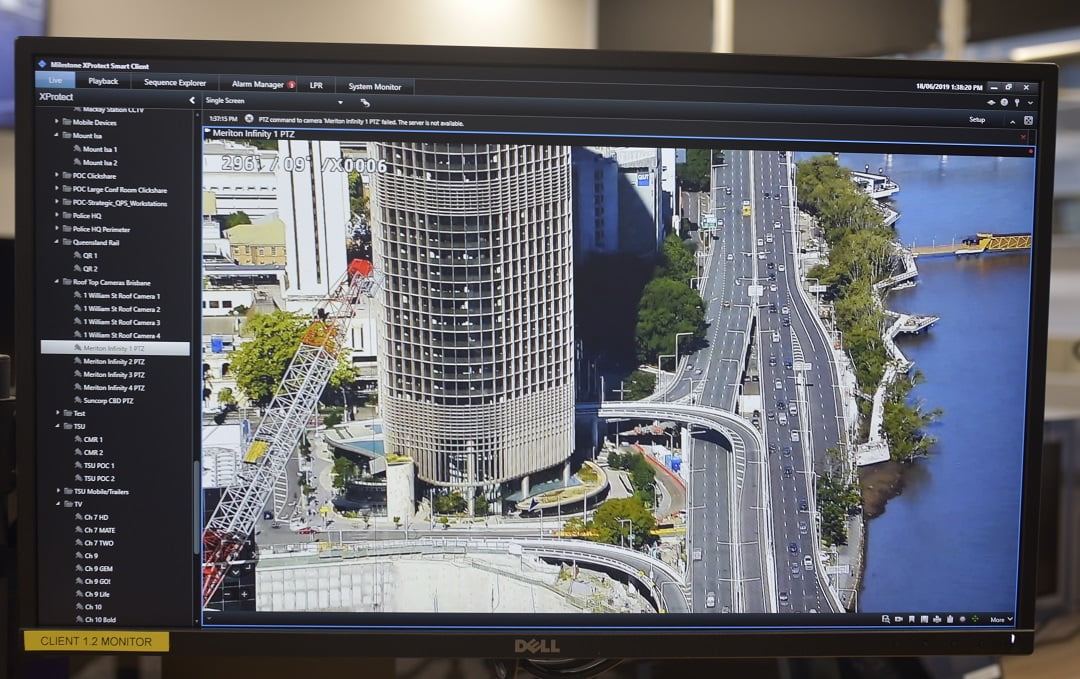
While it’s easy to forget local management of the Brisbane City Police station, that’s integral to this solution, too. With the Milestone-Inner Range high level integration when a door opens operators can view footage in the VMS or see it in Gatekeeper – it depends on the application as to which client is used to manage functionality.
“With the Integriti and Milestone high level integration there are multiple viewing options,” Cunningham explains. “If a functionality is more CCTV oriented then we will use Milestone but if it’s more access control oriented, we will use the Integriti Gatekeeper. It depends on how the user wants to drive the system and which is the most efficient way to deliver that requirement.
“Another aspect of the building system is LPR – the access control and CCTV systems are integrated in such a way that as authorised vehicles come into the carpark the boom gates open. The system uses the Milestone LPR system, however, the output from Milestone comes into Gatekeeper as a user. What this means is that when you look at the number plate it is assigned as a user and when it’s recognised by Milestone, a message is passed to Gatekeeper that the user is authorised, and Gatekeeper opens the boom gate – that’s the level of the integration. The Milestone server is processing, and Gatekeeper is actioning gate controls.
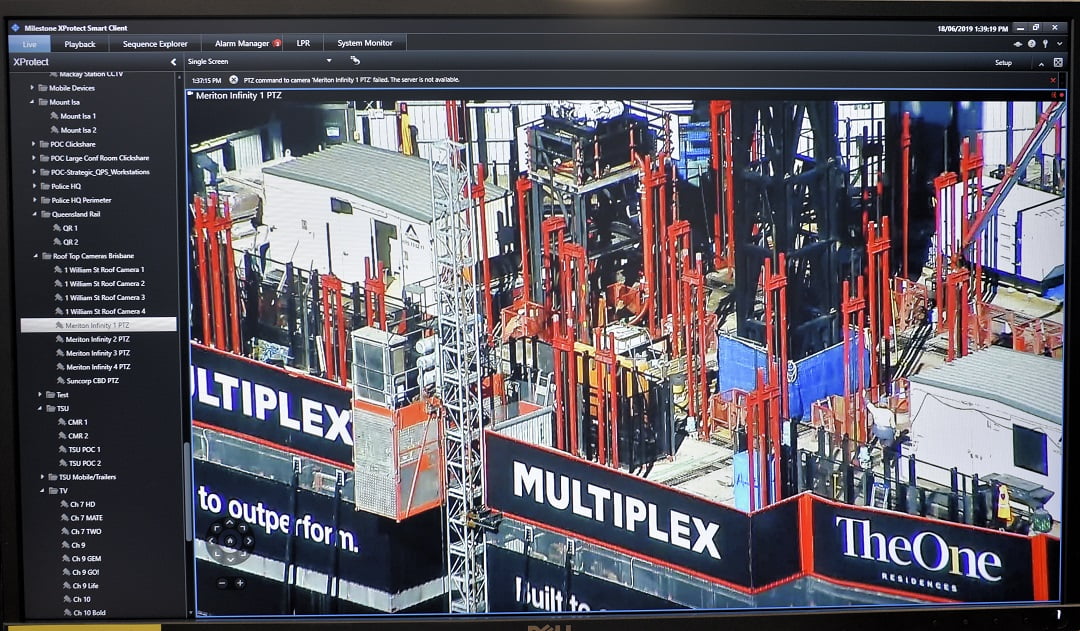
“In this application we also have lift control, which has been interesting,” Cunningham says. “What’s required to provide lift control for multiple agencies and who takes care of that? We’ve predominantly gone with QPS because of the higher security requirement – from the QPS system we administer all the other floors. Building management needed to understand that, which was a process.”
Next, we take a walk through the site to check out the cameras, the access control panels, the UPS and network components – it’s all nice work. The building has tight spaces, but everything is thoughtfully managed, and the work of the installers looks first class. While we are heading downstairs, we check out the interview rooms, the holding cells complete with Vivotek corner cameras and duress buttons. Clearly, the access control, intrusion and video surveillance components of this site are vitally important to its safe and efficient operation.
Bravis Installs Integriti Milestone Axis For QPS – Conclusion
Trying to articulate a solution like this one is tough – I arrived at the site expecting to see a largely self-contained integrated electronic security solution and came away struggling to encapsulate the system’s true nature. While this integration provides access control and CCTV support for the Brisbane City Police Station, its wider role is to bring together cameras from remote systems to provide QPS state-wide situational awareness in real time. Central to the story is the fact that you don’t click your fingers and create the potential to display thousands of cameras drawn from multiple systems. It takes planning – lots of planning – and lots of talking.
The central idea at QPS operations centre was to duplicate the functionality offered by the State Police Operations Centre, which was built for the G20 and has become an integral part of Queensland’s state-wide disaster response infrastructure. The SPOC has 65 workstations and allows police, fire, medical, military and federal agencies to work together in the event of a crisis. This new QPS operations centre room delivers the same sort of situational awareness to QPS when required it and provides redundancy for the SPOC, which is located a few blocks away. As part of my visit, we tour the SPOC – it’s an amazing facility that demands a story of its own.
“I’ve had a vision of an integrated solution like this for years – this is an application I’ve poured my heart and soul into,” Cunningham explains. “I sat at the G20 watching the State Police Operations Centre evolve and later said to QPS – you can have this, and it would work this way. Just decide what you want the system to do and let’s work out how to get you there. Of course, the role of the system is evolving, too – the creation of redundancy for the State Police Operations Centre means we will need to create a head end at this location, and we’ve just ordered the hardware to build it.”
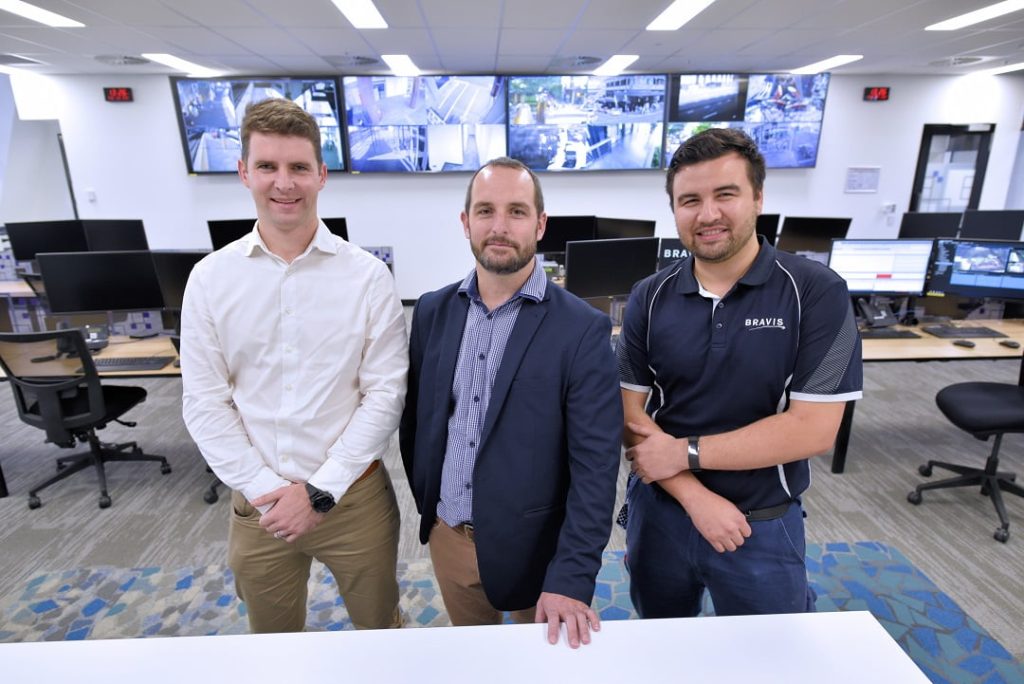
According to Senior Sergeant O’Connor, while the installation process proceeded relatively smoothly, it was a process that required hands-on management.
“An issue was that this 35-year-old building was not designed for our purposes,” he explains. “Although we had a total internal demolition and we have all new technology here, walls can’t be moved, so we were trying to fit a square peg into a round hole in some places. The risers were in certain locations, the comms rooms varied in size, the ops room space is fixed, the carpark ceiling is low – you are constrained by the physical structure and must fit things into the environment, not design the environment to meet your requirements.
“It was a relatively long process, thanks to the refurbishment of this building. Work started in 2018 but we had been talking and planning from late 2017, with practical completion on February 7 this year, and the police station operational 9 days later. We had put together a concept outlining what we wanted and Bravis, which was contracted to the builder, had to find a way to make sure we got what we wanted as far as possible by practical completion – and with the least number of variations.
“There were also some pressures from our perspective – we had to get out of our building before the end of our lease. We also needed to make sure we got what we wanted from our new security and surveillance solution – I believe we have certainly achieved that outcome.”
You can read more about Inner Range Integriti here and see more SEN news here.
“Bravis Installs Integriti Milestone Axis For QPS.”



